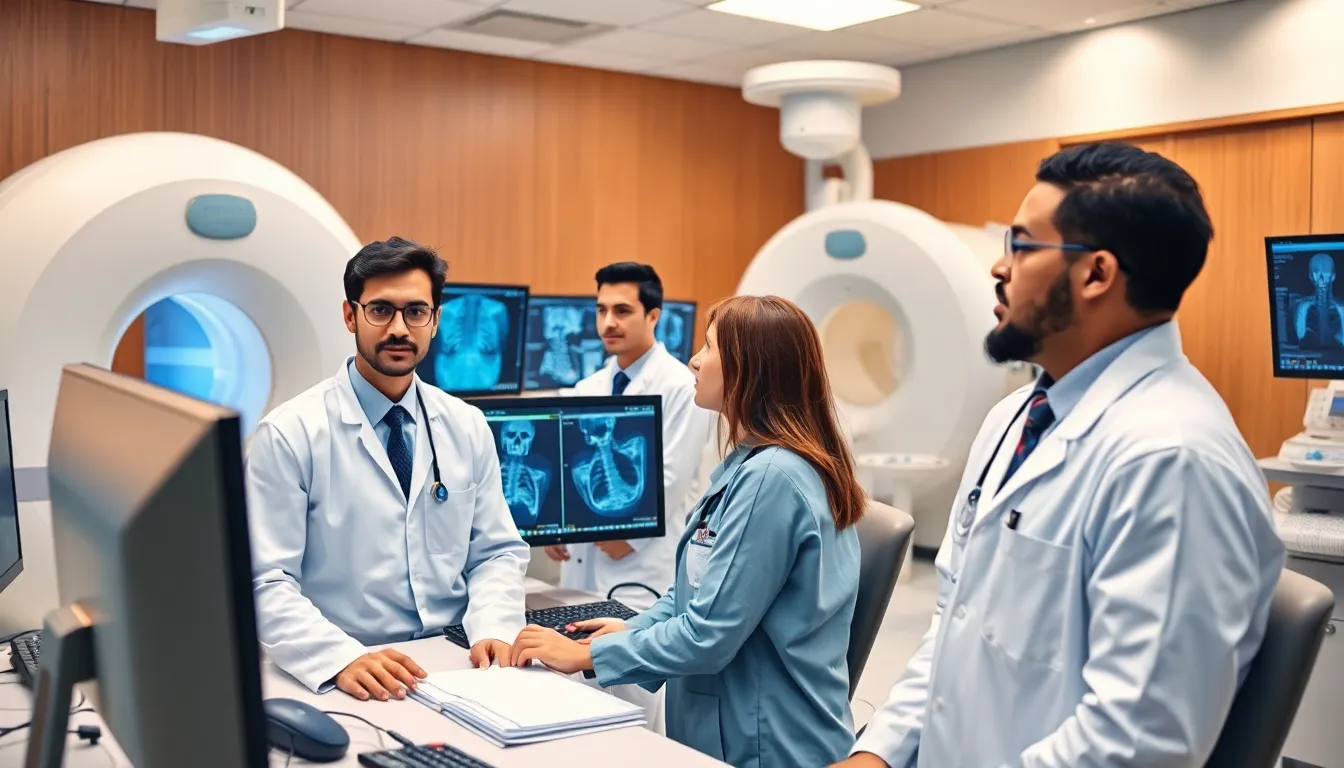In the ever-evolving world of medicine, artificial intelligence is making waves like a kid in a candy store. When it comes to radiology, AI isn’t just a helpful assistant; it’s the superhero every radiologist didn’t know they needed. Imagine a sidekick that never gets tired, never needs coffee breaks, and can analyze images faster than you can say “CT scan.”
As AI tools become more sophisticated, they’re transforming how doctors diagnose and treat patients. These smart algorithms sift through mountains of data, spotting anomalies that might slip past even the keenest human eye. It’s not just about speed; it’s about accuracy, efficiency, and maybe even a bit of magic in the mix. Dive into the fascinating intersection of artificial intelligence and radiology, where technology meets healthcare in a way that could save lives and lighten the load for medical professionals.
Table of Contents
ToggleOverview Of Artificial Intelligence And Radiology
Artificial intelligence (AI) significantly impacts radiology, transforming diagnostic processes. Algorithms analyze medical images rapidly, identifying abnormalities that may escape human observation. Such advancements enhance diagnostic accuracy, contributing to better patient outcomes.
Numerous AI applications streamline workflows in radiology. Automated image analysis tools assist radiologists in interpreting scans and prioritizing cases effectively. This efficiency increases the throughput of radiology departments, enabling practitioners to handle larger volumes of imaging studies.
AI enhances decision-making by providing valuable insights through data. These insights draw from extensive datasets, enabling machines to recognize patterns in complex images. Consequently, radiologists benefit from these tools, as they augment their diagnostic capabilities.
In addition, machine learning algorithms continuously improve through exposure to new data. As these systems engage with a broader range of cases, their accuracy and reliability increase. With ongoing advancements, AI tools evolve, integrating the latest research findings to refine their algorithms.
Collaborative efforts between AI developers and healthcare professionals play a crucial role. Experts in radiology contribute clinical knowledge, ensuring AI solutions meet real-world needs. This synergy fosters innovations that are both practical and clinically relevant.
With AI’s growing role, maintaining ethical considerations remains essential. Safeguarding patient privacy and ensuring data security are critical in AI implementation. Healthcare organizations must prioritize rigorous testing and validation to ensure these technologies provide safe, effective solutions in radiology.
Applications Of Artificial Intelligence In Radiology

Artificial intelligence significantly enhances various aspects of radiology, making processes more efficient and accurate.
Image Analysis
AI systems excel at analyzing medical images, swiftly identifying abnormalities such as tumors, fractures, and lesions. Radiologists gain support from algorithms that detect patterns in images too subtle for the human eye. Machine learning models continuously learn from new data, improving their diagnostic capabilities over time. An example of this advancement is the use of convolutional neural networks, which outperform traditional methods in image classification and segmentation tasks. AI not only increases diagnostic accuracy but also reduces the risk of misdiagnosis, ultimately benefiting patient outcomes.
Diagnosis Support
AI serves as a robust tool for diagnosis support within radiology departments. Algorithms analyze historical data and correlate findings with clinical outcomes, guiding physicians in making informed decisions. By providing insights that highlight possible conditions, AI narrows down differential diagnoses based on image evaluations. For instance, systems might suggest the likelihood of specific diseases, allowing radiologists to focus on critical cases first. Such collaboration enhances the overall effectiveness of healthcare professionals, facilitating quicker and more reliable diagnoses.
Workflow Optimization
Workflow optimization in radiology benefits tremendously from AI integration. Automation of routine tasks frees radiologists to concentrate on complex cases that require their expertise. AI-driven scheduling systems prioritize cases based on urgency and complexity, allowing departments to manage workloads more effectively. By streamlining image acquisition, interpretation, and reporting processes, organizations increase throughput, thereby reducing patient wait times. Enhanced efficiency in workflows translates into improved patient care and satisfaction, highlighting AI’s essential role in modern radiology practices.
Benefits Of Integrating Artificial Intelligence In Radiology
Artificial intelligence brings significant benefits to the field of radiology. Its integration enhances diagnostic accuracy and increases efficiency, ultimately improving patient care.
Improved Accuracy
Enhanced diagnostic accuracy represents a major advantage of AI in radiology. Algorithms meticulously analyze medical images, identifying abnormalities like tumors and fractures that might evade human detection. Studies demonstrate that AI can outperform human radiologists in specific tasks, consistently providing reliable results. With ongoing learning from extensive datasets, machine learning models refine their ability to recognize patterns in complex images. This continuous improvement leads to increased trust in AI-assisted diagnoses, allowing healthcare professionals to make better-informed decisions. Increased accuracy not only enhances patient outcomes but also reduces the occurrence of misdiagnoses, fostering greater clinician confidence in AI tools.
Time Efficiency
Time efficiency stands out as another crucial benefit of AI integration in radiology. Workflow optimization through automation significantly reduces the time radiologists spend on routine tasks. AI systems prioritize cases based on urgency, enabling clinicians to focus on complex cases requiring more attention. The rapid analysis of images allows for quicker turnaround in results, which is essential in emergency situations. With an ability to handle large volumes of data simultaneously, AI expedites processes, resulting in faster diagnostic pathways. This efficiency ultimately leads to reduced waiting times for patients, enhancing their overall satisfaction with the healthcare experience.
Challenges And Limitations
Artificial intelligence in radiology faces several challenges that may hinder its full potential.
Data Privacy Concerns
Data privacy remains a significant concern in AI applications. Patients’ medical images and health data require strict confidentiality. Breaches in data security can lead to severe consequences. Compliance with regulations such as HIPAA is essential to protect patient information. Implementing robust security measures can mitigate risks associated with data handling. Unauthorized access to sensitive data may undermine the trust between patients and healthcare providers. As AI applications grow, addressing these privacy issues becomes increasingly critical.
Need For Human Oversight
Human oversight plays a crucial role in AI-assisted radiology. Despite AI’s capabilities, interpreting complex medical images often needs expert validation. Radiologists’ expertise ensures accurate diagnoses, providing a safety net against potential AI errors. Incorporating human judgment into the diagnostic process can enhance patient safety. AI algorithms should serve as supportive tools rather than replacements for human professionals. Collaboration between AI systems and radiologists helps maintain diagnostic integrity. Continuous monitoring of AI performance ensures adherence to high quality standards.
Future Trends In Artificial Intelligence And Radiology
Emerging trends in artificial intelligence and radiology highlight advancements that change the healthcare landscape. Enhanced algorithms focus on improving accuracy, enabling AI to deliver even more precise image analysis. Radiologists increasingly leverage AI for routine tasks, allowing them to concentrate on intricate cases that require human expertise. Real-time data processing offers immediate insights, significantly speeding up diagnostics in emergency scenarios.
Innovations in machine learning will continue to refine pattern recognition, enhancing the identification of complex abnormalities. Collaboration between AI developers and healthcare professionals is vital, ensuring that AI systems align with clinical needs and improve patient safety. Regulatory frameworks will evolve alongside technology to address data privacy concerns, ensuring compliance with standards like HIPAA.
Integrating AI in radiology is expected to yield more robust diagnostic tools. Radiologists can expect to see AI assist in treatment planning, correlating medical imaging with patient histories and outcomes. Streamlined workflows will emerge, as AI automates data entry and case prioritization, leading to increased efficiency in radiology departments.
Ongoing research will yield novel AI applications, particularly in predictive analytics, transforming how radiologists approach patient care. As AI systems become more sophisticated, their role in assisting with routine assessments will likely expand, leading to faster and more accurate diagnoses. Ethical considerations will remain paramount, driving the need for transparent practices in AI development and implementation to retain patient trust.
These trends signal a promising future for artificial intelligence in radiology, emphasizing an effective synergy between technology and human expertise in enhancing patient care.
Artificial intelligence is reshaping the landscape of radiology in remarkable ways. Its ability to enhance diagnostic accuracy and streamline workflows is revolutionizing patient care. As AI continues to evolve, it’s set to play an even more integral role in treatment planning and decision-making.
The collaboration between AI developers and radiologists is crucial for maximizing the benefits of this technology. By combining machine learning with clinical expertise, the future of radiology looks promising. Ongoing advancements in AI will likely lead to more efficient processes and better patient outcomes while maintaining ethical standards and data security.
As this synergy between technology and human insight develops, the healthcare industry can expect a significant transformation that prioritizes patient safety and satisfaction.


